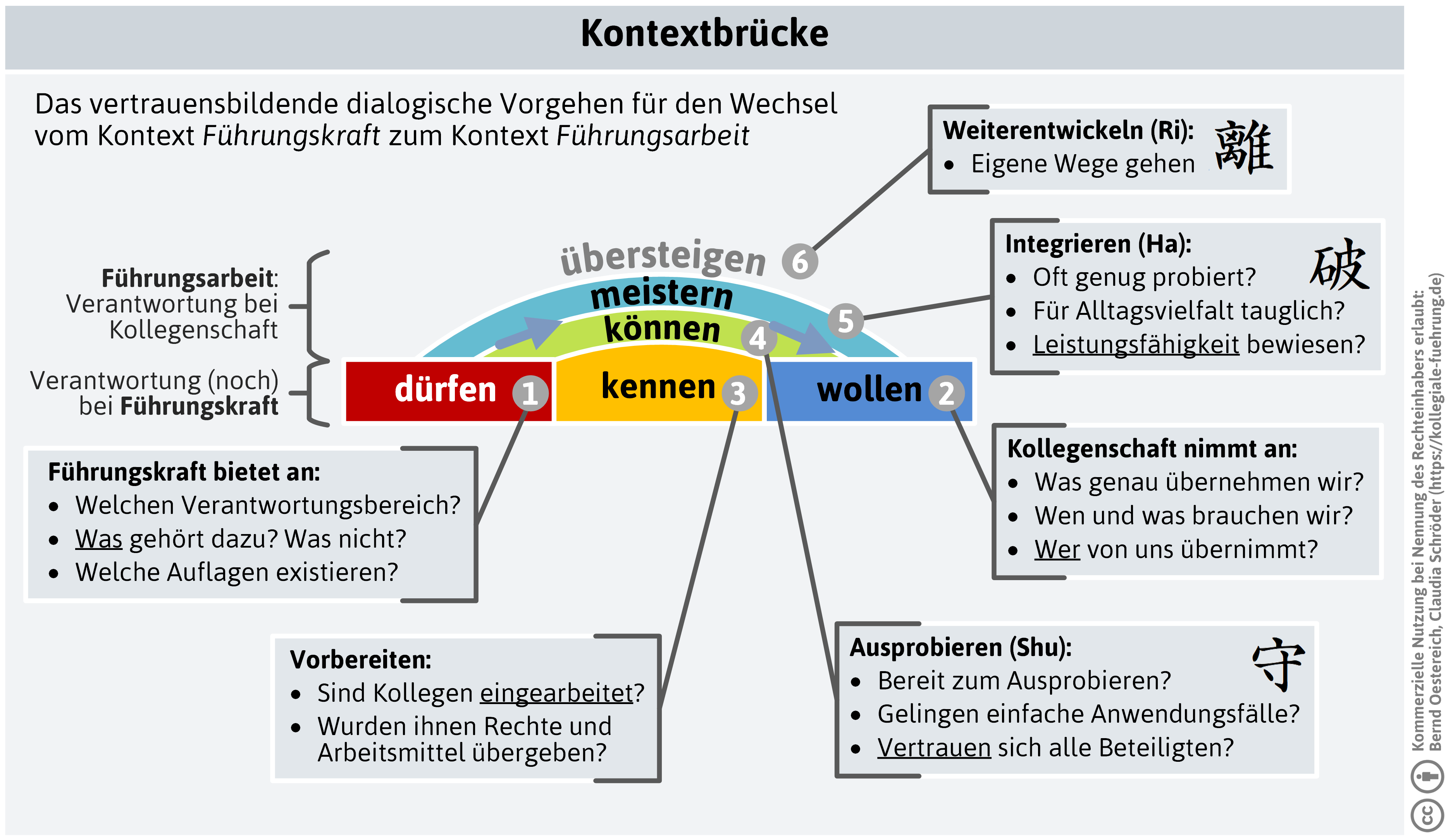Leadership | Agile Leadership
Giving decision-making authority to the team - a step towards more self-organisation and agility
From Sebastian Brumm, organisational consultant at netzwerk managementberatung | coaching
In order for companies to gain speed and remain able to act and compete even in times of rapidly changing markets, the decision-making competency of employees and teams must be strengthened. The fact that many companies are dealing with this is also made clear by the fact that established management approaches are being reconsidered and alternative approaches such as "agility" and "self-organisation" are being discussed or experimented with. But what exactly is behind these two buzzwords and how can the philosophy behind them be implemented in concrete terms? In this article we deal with a central core competency of agile companies: the decision-making competency of teams.
In agile organisations, decision-making responsibility is handed over to teams because more robust solutions emerge by including multiple perspectives and delays are reduced by the "bottle neck" boss. This raises the question: What do employees need in order to actively take on this extended responsibility and also make decisions productively in the group?
Clarity of purpose, trust and transparency at management level are prerequisites for successful delegation of decision-making authority.
Especially in organisations where hierarchical and process-oriented leadership styles and decision-making processes have been consolidated for many years, change will not happen "overnight". It means a cultural change, and thus fundamental and continuous work on both sides; the leaders and the staff.
A model of thinking that we like to refer to in change processes is described by Bernd Oesterreich and Claudia Schröder in "Agile Organisational Development" as the "context bridge".

The change from hierarchically led to self-organised, collegially led teams requires several steps. The starting point must be set by the leader by handing over responsibility to the team (being allowed to) and also communicating this in an understandable way (knowing how to do it). After the team accepts the responsibility (want to), an iterative procedure follows: with the three-step process of trying out (being able to), integrating (mastering) and further developing (exceeding), new forms of decision-making are consolidated and adopted in everyday life (three stages of learning: "Shu-Ha-Ri").
What exactly has to be done?
1. Create a cultural framework in the company:
Three foundations for a successful change in the corporate and decision-making culture can only be laid by the management level:
- Create clarity of goals
All employees should have internalised the company's vision and mission as well as the defined short- and medium-term goals: What exactly do we want to do? Why do we want to change the decision-making culture in the company? What exactly does this mean for us? - Establish clarity about the scope for decision-making
What is the team allowed to decide alone and what is not? How are decision-making processes that lie outside the team's competency handled? Who is involved? The supervisor or another team? These questions need to be answered clearly in advance. - Establish transparency
Knowledge and information no longer have a status character but are available to all. In this way, employees are put in a position to make decisions. - Give confidence
Self-organised teams must be allowed to decide within the defined framework what they may and know their scope and the sources of information. This implies that superiors have to respect decisions made - even if they consider them to be wrong decisions. In such cases, giving trust also means giving confidence, deal constructively with mistakes and understand them as part of learning and development processes.
Cf. Oops! 10 tips for a constructive culture of fault tolerance.
These cultural frameworks ensure the "may" and prepare the "want". What else is needed?
2. Recognise the change in the decision-making culture as a transformation process and plan time for it
The change will only be effective if the employees also accept it and want the responsibility that comes with it. Only then are they willing to go through corresponding learning and development processes and acquire new competencies. This willingness, i.e. intrinsic motivation, is achieved when employees see a personal benefit in the new decision-making processes and feel a sense of security that makes it possible to step out of the comfort zone. In addition to the aforementioned cultural prerequisites, this requires time and a "policy of small steps".
3. Internalise the process and build competencies
What do staff members have to be able to do in order to make good quality decisions in a team within a reasonable timeframe?
A group decision-making process that has proven itself in practice is the consent decision from sociocracy. A so-called "consent" is defined as the absence of serious objections (that jeopardise the common goal).
Four principles are important for the successful use of the consent process:
1. Alignment with the common goal
A common goal replaces personal preferences and interests in decision-making, which otherwise often influence the discussion subliminally.
Concrete measure for stabilisation:
- Include a question about a common goal on a regular basis, e.g. in team meetings during status reports. "Which goal is the focus of your current everyday decisions?"
- Demand concrete formulations of results.
2. Integration of multiple perspectives
The perspectives of all employees are consistently integrated from the beginning of the process.
Concrete measure for stabilisation:
- Establish a fixed order of speaking, e.g. in a circle or one after the other by calling them up.
3. Separation of information and opinion
Before exchanging opinions in decision-making situations, there are first questions to clarify understanding.
- What questions of clarification do you have?
- What is your opinion on the proposal?
Concrete measures for stabilisation:
- Separate meeting agendas according to information and opinion.
- Use targeted visualisation, e.g. in two columns for "questions of clarifaction" and "opinions".
4. Solution-oriented inclusion of objections
Objections are welcome because they help to improve the solution. How objections are dealt with also affects the acceptance of the solution and ultimately the implementation of the decision taken.
Concrete measures for stabilisation:
- Solution-oriented questioning: "How do we need to change the solution so that you can go along with the decision?"
In order to anchor these four principles in the team, the team members need the following competencies:
- Communication skills: How can we bring individual perspectives into the team in an appropriate and understandable way?
- Conversation skills: How do I get relevant information about the other stakeholders in conversations?
- Facilitation skills: How can I set impulses that lead us to new solutions?
- Conflict skills: How do I manage to keep the group's focus on solutions even in controversial discussions and contentious decision-making situations?
Practice
Finding the entry point for your own company
The principles anchored in the consent process provide an orientation framework for a change in decision-making culture. The necessary competency development is itself a continuous process and a leadership task.
If you see an opportunity in a change of decision-making culture in your company, the following questions will help you to deal with it in more detail and find an answer for yourself if and how you should initiate this change:
- How do we currently make decisions?
- Which decisions are currently taking too long?
- In which areas are we currently not satisfied with decisions?
- Which of the four principles do we already experience in our company?
- Which ones would amount to culture shock?
- Are we capable of mastering it?
- What competencies do we already have? Where?
- Which ones would we have to rebuild?
- Where can we create spaces for trying things out?
Conclusion
Decision-making culture - central factor in the transition to self-organised and agile working
The decision-making culture is a central factor in the transition to self-organised and agile working in teams and organisations. Consent decision-making offers teams a common learning and experience space to develop essential competencies. As a leader, you create good conditions for rapid further development if you engage in the three-step Shu-Ha-Ri and accompany the team with a high tolerance for mistakes.



